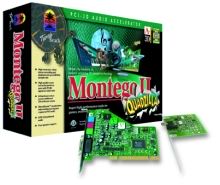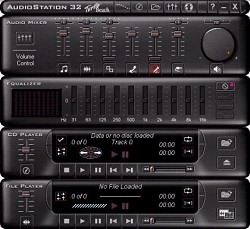| Turtle Beach Montego II Quadzilla
by Tim "Flyboy" Henderson |
||||
|
In May of 1998 we reviewed the Turtle Beach Montego and awarded it our TOP PICK for quality and overall performance. Not long afterward Aureal announced their Vortex II chipset, and we anticipated a great step forward in the evolution of PC sound hardware. We weren't disappointed. The Vortex II chipset is a great milestone in gaming hardware, and while the price of a top end sound board has dropped, the power has increased greatly. The number of hardware voices has tripled, and the number of simultaneous DirectSound and DirectSound3d streams has likewise increased. Diamond was the first to market with their MX300, and Turtle Beach followed not long afterward with their Montego II. But some reviewers were disappointed. While Diamond's board sported twin outputs, allowing direct connection for up to four speakers, the Montego II only had a single output. It turns out that Turtle Beach had something better in mind. Test System:
Technical Specs
|

Installation Two slots are required by the Quadzilla since it is bundled with the daughtercard. Why did Turtle Beach go this route? There were three key reasons: Real estate. TB heard from a number of users that the back of cards were already too jammed with jacks and that adding two others, especially when using bulky high-end cables (such as a metal-jacketed RCA plug), would only cause frustration. It allows them to use the same base card that they developed for Dell systems, reducing the need to develop an entirely different retail card (and thus keeping the board cost down for the end-user in the process).  AudioStation32 It allowed for modularity. If a Quadzilla owner wants to move up to the higher-end bracket board that they are releasing (RCA and optical I/Os), they can do so easily. At the same time, this design allows the hundreds of thousands of people who have bought or will buy the OEM board in a Dell system to add the S/PDIF and rear speaker capability. Zimple isn't it? I inserted the CD on boot up and the board was detected by WIN98. Driver installation went smoothly. The typical midi and wav file utilities are included, as well as Hip Hop eJay and X-Wing Alliance. I had some fun playing with the EQ in AudioStation32. Watch out for Orchestrator Plus, it's a time gobbler! Go to Page Two
|
|||
|
Copyright © 1997 - 2000 COMBATSIM.COM, INC. All Rights Reserved. Last Updated July 8th, 1999 |
||||
